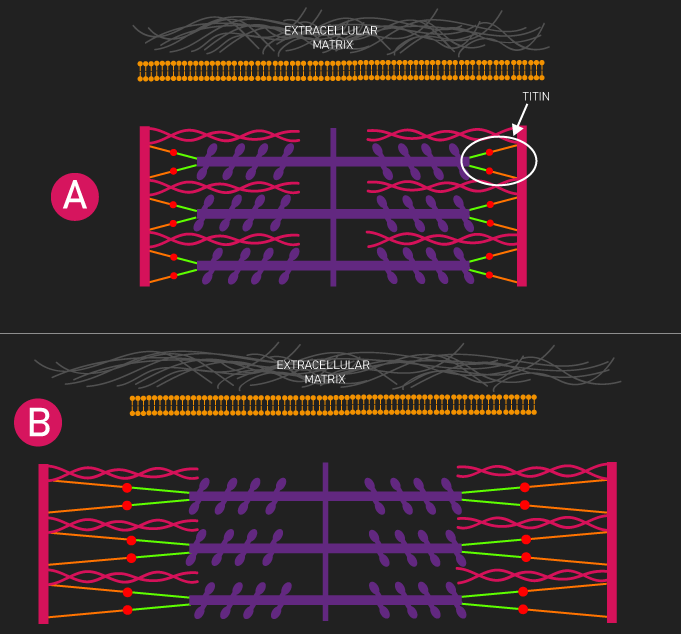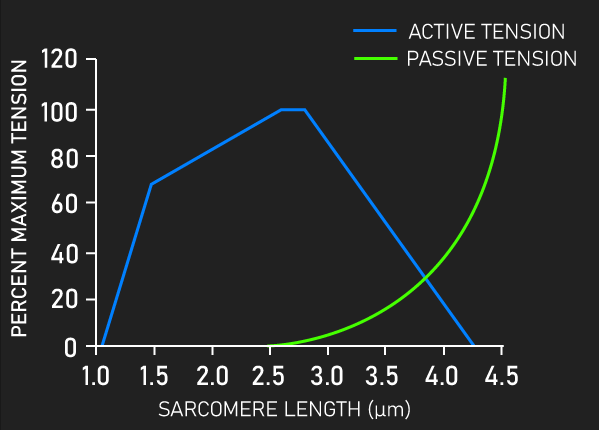
The length-tension relationship demonstrates that the amount of force produced by sarcomeres (the contractile units of muscle) depends on its length.
Table of Contents
Basic Anatomy & Physiology of Muscles
To fully grasp this concept, it’s important to have an understanding of what’s inside a muscle and how a muscle produces force.
The image below demonstrates the hierarchical layers of a muscle:

As we can see, within muscle fibers are myofibrils, and within myofibrils are sarcomeres.
There are two ways a muscle can produce force, through active tension or passive tension.
Active Tension
Active tension occurs when the myosin head extends from the myosin filament and pulls the actin filament towards the M-line, shortening the length of the sarcomere.

B) The myosin heads extend from the myosin filaments and attach to the actin filaments.
C) The myosin filaments pull the actin filaments towards to M-line, shortening the sarcomere length.
This action produces force that is partly transmitted longitudinally, but mainly laterally to the extracellular matrix (surrounding muscle fibers). These forces end up pulling on the tendon, resulting in muscle contraction.

Passive Tension
Passive tension is the force generated through the stretch of muscle fibers. Within the sarcomere, a molecule called titin appears to play a large part in passive tension.

Stretch of the sarcomere also results in stretching of titin, resulting in passive force production. Think of a rubber band, tension is generated when you stretch it, and if you suddenly let go, this tension snaps it back to the original length.
Outside of the sarcomere, it’s also believed stretching of the extracellular matrix (which surrounds muscle fibers) produces passive force.
The Length-Tension Relationship
So, now that we understand the basics of how a muscle produces force, let’s relate these ideas to the length-tension relationship.
In this relationship, the length of a sarcomere is on the x axis, while the amount of tension (analogous to force) produced by a sarcomere is on the y-axis.

There are two components to the length-tension relationship, active tension and passive tension.
Let’s first focus on active tension.
Active Tension

I’ve labeled five different points on the active tension component.
Let’s go through each of these five points.
1) Excessively short sarcomere lengths result in little to no force production. At this length, the opposite actin filaments overlap with one another to some degree. This overlap prevents many of the myosin heads from extending and pulling on the correct actin filament. As a result, little force is produced.

2) Increasing the length of the sarcomere slightly removes some of the overlap between the opposite actin filaments, allowing some of the myosin heads to extend and pull on the correct actin filament. Therefore, the sarcomere can generate some force.

3) Increasing the sarcomere length slightly again removes any opposing actin filament overlap. Consequently, all the myosin heads can extend and pull the actin filament towards the M-line. This particular region of the length-tension relationship is known as the optimal length, as it is the length that allows the most amount of active tension.
As a note, the optimal length isn’t one particular length, it is a region (2.6-2.8μm in humans), the small plateau region on the graph demonstrates this.

4) Further increasing the length of the sarcomere results in the actin filaments moving away from the myosin filament. This means that some myosin heads are not overlapping with the actin filament, meaning they cannot extend and pull the actin filament. Because fewer myosin heads can contribute to force here, active force production is less.

5) At this point, there is no overlap between the myosin heads and actin filaments, thus no myosin head can extend and pull the actin filament. Accordingly, no more active tension can be produced.

Passive Tension

Moving on to the passive component, demonstrated on the graph, passive tension begins to develops when the sarcomere is lengthened to some degree. From here, passive tension sharply increases.
This makes sense, at short sarcomere lengths, titin is slack. Therefore, the sarcomere needs to lengthen to uncoil and stretch titin.

Note, in all of the length tension relationship graphs shown in this article, passive tension begins to develop at a sarcomere length of 2.5μm. This would likely not be the case with all muscles. evidence indicates the passive tension curve is variable (much more so than the active tension curve), so keep this in mind.
Before moving on, if you’re curious about creating an effective training program for muscle hypertrophy, our high quality partner Alpha Progression can help. It can generate a highly effective program for you, track your workouts live with in-built progression recommendations, provide graphs displaying your long term progress, and it has a massive exercise database with more than 550 exercises.
Click HERE (the link opens in a new tab) to get a free 2 week trial of the apps features. If you like it and go beyond, the link also gives you 20% off a subscription!
We never promote trash at the House of Hypertrophy, so rest assured the app is high quality. The reviews speak to this, 4.8 starts (based on more than 7,000 reviews) on Google play, and 4.9 stars in Apple’s store (based on nearly 400 ratings).
The Length-Tension Relationship and Hypertrophy
Okay, so now that we understand what the length-tension relationship is, let’s relate it to what we care about, building muscle.
The length-tension relationship has direct implications for the primary (physiological) driver of muscle hypertrophy, which is mechanical tension.
Mechanical tension is equal to the amount of force generated by a muscle. As we have already established, active tension and passive tension are the ways a muscle generates force.
It’s believed mechanosensors detect these forces and subsequently initiate a signaling cascade that results in muscle hypertrophy.
To achieve high levels of hypertrophy, we would want high levels of mechanical tension.
To achieve high levels of mechanical tension, the combination of active and passive tension is likely beneficial.
In other words, during an exercise, we would want sarcomeres to go through a range of motion that allows them to produce high amounts of active tension (plateau region) and high amounts of passive tension (near their end range of motion).
At the same time, we would want to avoid the sarcomeres being excessively short for the whole duration of an exercise. Because as we’ve established, sarcomeres produce no force when excessively shortened.
From this, you may be thinking a full range of motion on an exercise (moving a muscle from a short length to a long length), would ensure we move the sarcomeres throughout their full range of motion. This should ensure the sarcomeres aren’t excessively short for the whole duration of an exercise, while allowing high levels of active and passive tension to develop.
However, this would be assuming that the length of a sarcomere is no different from the length of a muscle.
For instance, when a muscle is fully shortened, you would be assuming the sarcomeres within the muscle are fully shortened too. When the muscle is fully lengthened, you would be assuming that the sarcomeres within the muscle are fully lengthened as well (where passive tension is high).
Although this is a very reasonable assumption, it isn’t actually always the case.
Different muscles have sarcomeres organized in different ways that directly impact the length their sarcomeres can operate at during any movement.
For instance, this study by Murrary et al. estimated that the sarcomeres within the long head of the triceps seem to operate primarily on the plateau region of the length-tension relationship throughout elbow range of motion.

At 30 degrees of elbow flexion (close to the triceps being fully shortened), the sarcomeres within the long head of the triceps are not fully shortened, rather they seem to be slightly before/at the start of the plateau region of the length-tension relationship.
At 120 degrees of elbow flexion (close to the triceps being fully lengthened), the sarcomeres within the long head of the triceps are not fully lengthened, rather they seem to be at the end of the plateau region of the length-tension relationship.
This information suggests that using a full range of motion with triceps exercises would probably not *enhance* growth of the triceps long head, simply because passive tension would likely not meaningfully occur at long triceps lengths
Also, performing triceps exercises with partial ranges of motions that have the muscle primarily working through a short length would likely not be detrimental to long head growth, as their sarcomeres do not appear to be excessively shortened when the triceps are shortened.
Let’s contrast this with the vastus lateralis (one of the muscles of the quadriceps).

Son et al. estimated that when the quadriceps were fully shortened (full knee extension), 2.3 μm was the predicted length of the sarcomeres within the vastus lateralis (so just before the plateau region).
When the quadriceps were stretched (knees flexed to 100 degrees), 3.8μm was the predicted length of the sarcomeres within the vastus lateralis.
This information suggests that using a full range of motion with quadriceps exercises would probably enhance growth of the vastus lateralis, because passive tension would likely meaningfully occur at long quadriceps lengths.
Also, although longer ranges of motions that stretch the quadriceps are likely better for growth (due to passive tension), partial range of motion quadriceps exercises that primarily work the muscle through short lengths are probably not going to be terrible for growth. At this length, the sarcomeres within the vastus lateralis do not appear to be excessively shortened.
However, I must mention an important limitation when interpreting these results. Researchers typically take a sample from a particular region of a muscle. Therefore, the results obtained are specific to that region and cannot always apply to the whole muscle.
This is noteworthy, as Lichtwark et al. found that sarcomere lengths vary at different regions of the tibialis anterior muscle. I think this is likely the case with many muscles in the human body.
But regardless, information regarding the length-tension relationship of particular muscles can be useful for predicting what exercises and range of motions can be optimal. Moreover, it can be used to support and potentially explain the results of long term studies assessing muscle growth.
I plan to write various articles on maximizing growth for particular muscle groups. In these articles, if the research is there, I will link to the length-tension relationship.
Remember to feel free to check out the Alpha Progression App if you’re interested. Also feel free to check out our free bench press e-book below.


Hi: Great article in that it finally answered the question of whole muscle and ROM vs actual sarcomere length variations. I know I assumed that based on the length-tension relationship that when doing a triceps press down the muscle would be placed on maximum stretch at the start but this is not the case at the actual sarcomere level.Potential interesting implications for exercise. Keep up the great work.
Awesome to hear, thank you!
Although the current evidence indicates the triceps sarocmeres aren’t significantly stretched at long lengths, remember they only measure the sarcomere lengths at one region of the muscle. At other regions of the muscle, perhaps there exists sarcomeres that are stretched. Overall, there isn’t a ton of research on the length-tension relationship for human muscles. Hopefully we get a lot more future research 🙂
Any advice or information that you have on bicep angles and maximum tension? This article really helped a lot regarding triceps but still struggling with bicep growth.
I’m not too sure the angle at which you train your biceps at is overly important. For instance, this study: https://pubmed.ncbi.nlm.nih.gov/32823490/ found that cable preacher curls (which places the stress on the biceps when they are more shortened) and barbell preacher curls (which places stress on the biceps when they are more lengthened) produced similar biceps growth, indicating that resistance-curves may not matter much for biceps growth.
Furthermore, it’s likely a good idea to include a few biceps exercises variations (that differ in angles used) in a routine, as doing so seems to ensure better growth across the length of the biceps. For example, this study: https://pubmed.ncbi.nlm.nih.gov/33440446/ found that compared to only performing barbell curls, performing barbell curls + preacher curls + incline dumbbell curls resulted in more growth across the biceps (volume, the number of sets performed for the biceps, was equated between these two different conditions, suggesting it was the greater exercise variation that explained these findings).
Hope this helps, feel free to ask/question anything 🙂